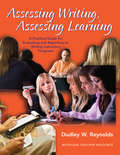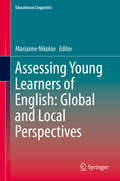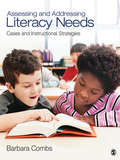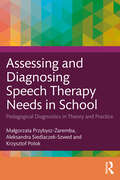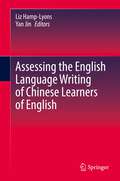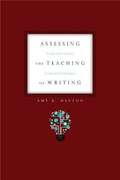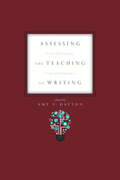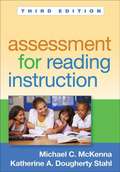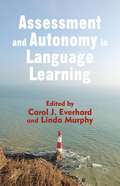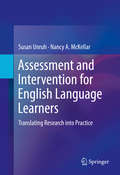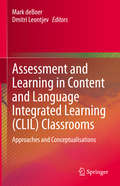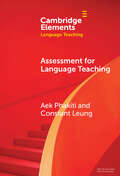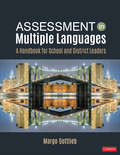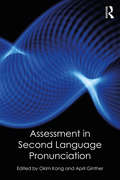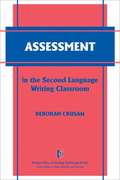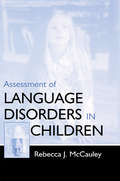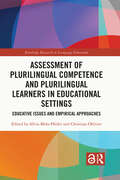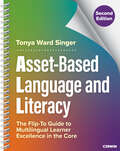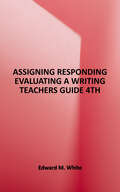- Table View
- List View
Assessing Writing, Assessing Learning: A Practical Guide to Evaluating and Reporting on Writing Instruction Programs
by Dudley W. ReynoldsThe goals of this resource are broader than many standard books on writing assessment, which focus on evaluating an individual's ability to create an effective piece of writing for a particular purpose. Assessing Writing, Assessing Learning seeks to support teachers, administrators, program directors, and funding entities who want to make the best use of the resources at their disposal to understand what students are learning and why and then take actions based on what they have learned. It also seeks to provide a common basis for communication among all the interested parties--the writing professionals, the people who identified the need for the program, and the students. The book has sections on planning, tools (different ways of collecting data and links to instruments), and reporting (examples provided). Each section includes a discussion of issues and advice for working through the issue along with numerous examples, plus a list of resources to consult to learn more. The final chapter provides worksheets that may be reproduced and used to help those in charge of setting up and delivering a writing program to think through the issues presented. A glossary of terms is also included.
Assessing Young Learners of English: Global And Local Perspectives (Educational Linguistics #25)
by Marianne NikolovThis volume documents international, national, and small-scale testing and assessment projects of English language education for young learners, across a range of educational contexts. It covers three main areas: age-appropriate 'can do statements' and task types for teaching and testing learners between the ages of 6 to 13; innovative approaches to self-assessment, diagnostic testing, self- perception, and computer-based testing; and findings on how young learners perform on vocabulary, listening, speaking, pronunciation, and reading comprehension tests in European and Asian contexts. Early language learning has become a major trend in English language education around the globe. As a result of the spread of teaching English to a growing number of young children, assessment of and for learning have emerged as key issues. In line with this development, there is a clear and emerging need to make early language programs accountable and to assess both the progress children make over time and to quantify their achievement at various stages of development. This volume informs stakeholders about the realistic goals of early language learning, their efficiency, and how much progress children make over time.
Assessing and Addressing Literacy Needs: Cases and Instructional Strategies
by Barbara E. CombsDesigned to help preservice and inservice teachers use assessments to identify problems and employ appropriate strategies to help their students become better readers, this text includes 12 case studies that detail children's literacy struggles. The cases are embedded within a framework of research-based instructional interventions related to best practices in literacy instruction. The core chapters of the book are organized around six essential elements in learning to read—emergent literacy, word identification, fluency, vocabulary, comprehension, and engagement—and include a review of the literature, assessment strategies, instructional interventions, a section on Intervening With Technology, and two detailed case reports.
Assessing and Diagnosing Speech Therapy Needs in School: Pedagogical Diagnostics in Theory and Practice
by Małgorzata Przybysz-Zaremba Aleksandra Siedlaczek-Szwed Krzysztof PolokAssessing and Diagnosing Speech Therapy Needs in School is a unique text that offers practical guidance in pedagogical diagnosis of speech and communication difficulties within educational settings It outlines theoretical assumptions of the diagnosis process and presents hands-on solutions for pedagogical and speech therapy. Underpinned by theoretical knowledge and written by experienced practitioners, the book equips its readers with tools to understand the diagnostic process and make accurate diagnoses based on each child’s individual circumstances. It starts by clearly distinguishing between pedagogy and speech therapy and outlines issues and theoretical considerations in diagnosing these disorders. To contextualize the theorical observations, it goes on to present case studies, and touches upon crucial topics including readiness to start education, tendency toward aggressive behavior, aphasia and hearing loss. The authors also elaborate on a range of selected diagnostic tools to assess specific difficulties in speech and language therapy. Finally, a list of resources, including games and exercises that can target reading, writing and articulation skills to help children develop, are also featured in the book. Highlighting the importance of practical and theoretical knowledge for those who work with children, this will be a valuable aid for teachers, special educators and speech and language therapists working within school settings. The book will also be of interest to students, teachers and trainee practitioners in the fields of speech therapy and special educational needs.
Assessing the English Language Writing of Chinese Learners of English
by Yan Jin Liz Hamp-LyonsThis book focuses on the assessment of English language writing in China mainland, the territories of Hong Kong and Macau, and Taiwan. The first part of the book describes how writing in English has been assessed in Chinese contexts in the past 25 years, and how it continues to be assessed at present. The second part of the book presents reports of work such as formative classroom-based assessment, feedback-based or feedback-led approaches, learning-oriented assessment, portfolios, as well as the important issue of teacher professional development in writing assessment. This two-part division relates to and reflects what has been happening in writing assessment internationally, in the UK from the 1940s, and in the US in the past 25 years.The use of English for international business communication, for international political negotiations and its rapidly increasing use as a medium of instruction in some subject areas has led to a rapid increase in the numbers of Chinese L1 speakers who are learning and being assessed in English. This is often done with an emphasis on reading and writing. The vast majority of assessments of English language writing are done through large-scale direct testing that uses simple prompts/tasks and short writing samples. This book explores best practices in assessing the writing in English of native speakers of Chinese.Assessing the English Language Writing of Chinese Learners of English edited by long-time experts Liz Hamp-Lyons and Yan Jin clearly demonstrates the authors’ collective years of writing and teaching about writing assessment. The book’s 13 chapters, written by recognized experts in assessment of Chinese speakers learning English, represent a wide array of important topics written in reader friendly language and offering evidence for pedagogical practices as well as high-stakes testing of writing. Teachers, researchers, administrators of writing programs in China, and test developers who seek counsel about this population need look no further than to add Assessing the English Language Writing of Chinese Learners of English to their reading list. Deborah Crusan, Wright State University, USA
Assessing the Teaching of Writing
by Amy E. DaytonAlthough fraught with politics and other perils, teacher evaluation can contribute in important, positive ways to faculty development at both the individual and the departmental levels. Yet the logistics of creating a valid assessment are complicated. Inconsistent methods, rater bias, and overreliance on student evaluation forms have proven problematic. The essays in Assessing the Teaching of Writing demonstrate constructive ways of evaluating teacher performance, taking into consideration the immense number of variables involved.Contributors to the volume examine a range of fundamental issues, including the political context of declining state funds in education; growing public critique of the professoriate and demands for accountability resulting from federal policy initiatives like No Child Left Behind; the increasing sophistication of assessment methods and technologies; and the continuing interest in the scholarship of teaching. The first section addresses concerns and advances in assessment methodologies, and the second takes a closer look at unique individual sites and models of assessment. Chapters collectively argue for viewing teacher assessment as a rhetorical practice.Fostering new ways of thinking about teacher evaluation, Assessing the Teaching of Writing will be of great interest not only to writing program administrators but also to those concerned with faculty development and teacher assessment outside the writing program.
Assessing the Teaching of Writing: Twenty-First Century Trends and Technologies
by Amy E. DaytonAlthough fraught with politics and other perils, teacher evaluation can contribute in important, positive ways to faculty development at both the individual and the departmental levels. Yet the logistics of creating a valid assessment are complicated. Inconsistent methods, rater bias, and overreliance on student evaluation forms have proven problematic. The essays in Assessing the Teaching of Writing demonstrate constructive ways of evaluating teacher performance, taking into consideration the immense number of variables involved. Contributors to the volume examine a range of fundamental issues, including the political context of declining state funds in education; growing public critique of the professoriate and demands for accountability resulting from federal policy initiatives like No Child Left Behind; the increasing sophistication of assessment methods and technologies; and the continuing interest in the scholarship of teaching. The first section addresses concerns and advances in assessment methodologies, and the second takes a closer look at unique individual sites and models of assessment. Chapters collectively argue for viewing teacher assessment as a rhetorical practice. Fostering new ways of thinking about teacher evaluation, Assessing the Teaching of Writing will be of great interest not only to writing program administrators but also to those concerned with faculty development and teacher assessment outside the writing program.
Assessment For Reading Instruction (Third Edition)
by Michael C. McKenna Katherine A. Dougherty StahlThis trusted teacher guide and widely adopted text provides a comprehensive conceptual framework and hands-on practical tools for reading assessment. The authors present a clear roadmap for evaluating K-8 students' strengths and weaknesses in each of the basic competencies that good readers need to master. <P><P>Teachers learn how to select, administer, and interpret a wide range of formal and informal assessments, and how to use the results to improve instruction. In a large-size format for easy photocopying, the book includes 30 reproducible assessment tools. Purchasers get access to a Web page where they can download and print the reproducible materials.
Assessment Literacy: An Educator's Guide to Understanding Assessment, K-12
by Thomas DeVere Wolsey Susan Lenski Dana L. GrishamThis clear, no-nonsense book guides current and future teachers through the concepts, tools, methods, and goals of classroom literacy assessment. The expert authors examine the roles of formative, summative, and benchmark assessments; demystify state and national tests and standards; and show how assessment can seamlessly inform instruction. Strategies for evaluating, choosing, and interpreting assessments are discussed, as are ways to communicate data to parents and administrators. User-friendly resources include boxed vignettes from teachers and researchers, practical assessment tips (and traps to avoid), and 12 reproducible planning forms and handouts. Purchasers get access to a Web page where they can download and print the reproducible materials in a convenient 8 1/2" x 11" size.
Assessment and Autonomy in Language Learning
by Carol J. Everhard Linda MurphyThis book examines this contested relationship between assessment and autonomy from a number of perspectives in a variety of Higher Education language-learning contexts in Europe and the Far East. The contributors to the book describe research into assessment both for and as autonomy, as well as approaches to the assessment of autonomy itself.
Assessment and Intervention for English Language Learners: Translating Research into Practice
by Susan Unruh Nancy A. MckellarThis book presents evidence-based practices for appropriate assessment of and school-based services for young English language learners. It identifies and addresses the challenges of assessing and intervening with these students at the curricular, instructional, environmental, and individual levels, particularly the complexities of determining the presence or absence of learning disabilities. Case studies and comparisons with fluent English speakers illustrate the screening and evaluation process - including multi-tier system of supports (MTSS) and response to intervention (RTI) - and proactive intervention planning in core literacy and math domains. Together, these chapters model effective teaching practice, advocacy, and teamwork with parents and colleagues as well as policy development toward meeting the needs of this diverse student population. This invaluable guide: Examines challenges of data collection when working with English language learners. Traces the development of dual-language fluency and competence. Discusses language-acquisition issues affecting oral language assessment. Reviews commonly used assessment and intervention tools in use with English learners. Features specialized chapters relating to reading, writing, and mathematics competencies. Can be used regardless of first language spoken by students. Assessment and Intervention for English Language Learners is an essential resource for researchers, professionals, and graduate students in diverse fields including school and clinical child psychology; assessment, testing, and evaluation; language education; special education; and educational psychology.
Assessment and Learning in Content and Language Integrated Learning (CLIL) Classrooms: Approaches and Conceptualisations
by Mark DeBoer Dmitri LeontjevThis volume builds a conceptual basis for assessment promoting learning in Content and Language Integrated Learning (CLIL) classrooms and proposes practical assessment approaches and activities that CLIL teachers can apply in the classroom. CLIL as an educational context is unique, as language and content learning happen simultaneously. The efficacy of such instruction has been studied extensively, but assessment in CLIL classrooms has drawn much less attention. The present volume aims to fill this gap. Arranged based on different ways that content and language are integrated in CLIL, the chapters in this book together build a solid theoretical basis for assessment promoting learning in CLIL classrooms. The authors discuss how assessment eliciting this integration yields insights into learners' abilities, but more importantly, how these insights are used to promote learning. The contributors to the volume together build the understanding of classroom-based assessment as cyclic, of teaching, learning, and assessment as inter-related, and of content and language in CLIL classrooms as a dialectical unity. This volume will spark interest in and discussion of classroom-based assessment in CLIL among CLIL educators and researchers, enable reflection of classroom assessment practices, and foster collaboration between CLIL teachers and researchers. The assessment approaches and activities discussed in the volume, in turn, will help educators understand the scope of applications of assessment and inspire them to adapt these to their own classrooms.
Assessment for Language Teaching (Elements in Language Teaching)
by Aek Phakiti Constant LeungThis Element reviews the key foundational concepts, beliefs, and practices underpinning approaches to assessment in English Language Teaching. Exploring major concepts and practices through educational, social, and ethical perspectives, it offers theoretically informed and close-to-practice descriptions and up-to-date explanations of the affordances and limitations of different assessment approaches related to language teaching. This Element presents a cohesive and pragmatic framework that allows teachers to efficiently implement tests and assessments in their contexts.
Assessment in Multiple Languages: A Handbook for School and District Leaders
by Margo GottliebAssessing the full capabilities of your multilingual learners Assessment as, for, and of learning complement effective curricular and instructional practices, however, the complexities of assessment for multilingual students are too-often overlooked and misunderstood. What if multilingual learners, teachers, and educational leaders all had opportunities to plan for and use assessment data in multiple languages? Imagine the linguistic, academic, and cultural reservoirs we could tap to highlight what our multilingual learners know and can do. Assessment in Multiple Languages: A Handbook for School and District Leaders shows how superintendents, principals, directors, coaches, and other educational leaders can more accurately portray the academic, language, and social-emotional development of multilingual students. As a companion to Classroom Assessment in Multiple Languages, this book illustrates how the assessment cycle unfolds at school and district levels. Together the two books provide comprehensive guidance for enacting linguistically and culturally sustainable assessment in multiple languages in K-12 settings. Grounded in leading-edge research, with an emphasis on instilling equity and social justice in assessment practices, this book: justifies the legitimacy of assessment in multiple languages showcases examples from federal to classroom levels provides practical guidance and tools for schoolwide and district level assessment applies to any and all programs with multilingual learners whether in dual-language immersion, bilingual, or monolingual settings. Written by leading multilingual education and assessment authority Margo Gottlieb, this guide will help educational leaders highlight the true capabilities of multilingual learners.
Assessment in Multiple Languages: A Handbook for School and District Leaders
by Margo GottliebAssessing the full capabilities of your multilingual learners Assessment as, for, and of learning complement effective curricular and instructional practices, however, the complexities of assessment for multilingual students are too-often overlooked and misunderstood. What if multilingual learners, teachers, and educational leaders all had opportunities to plan for and use assessment data in multiple languages? Imagine the linguistic, academic, and cultural reservoirs we could tap to highlight what our multilingual learners know and can do. Assessment in Multiple Languages: A Handbook for School and District Leaders shows how superintendents, principals, directors, coaches, and other educational leaders can more accurately portray the academic, language, and social-emotional development of multilingual students. As a companion to Classroom Assessment in Multiple Languages, this book illustrates how the assessment cycle unfolds at school and district levels. Together the two books provide comprehensive guidance for enacting linguistically and culturally sustainable assessment in multiple languages in K-12 settings. Grounded in leading-edge research, with an emphasis on instilling equity and social justice in assessment practices, this book: justifies the legitimacy of assessment in multiple languages showcases examples from federal to classroom levels provides practical guidance and tools for schoolwide and district level assessment applies to any and all programs with multilingual learners whether in dual-language immersion, bilingual, or monolingual settings. Written by leading multilingual education and assessment authority Margo Gottlieb, this guide will help educational leaders highlight the true capabilities of multilingual learners.
Assessment in Second Language Pronunciation
by April Ginther Okim KangAssessment in Second Language Pronunciation highlights the importance of pronunciation in the assessment of second language speaking proficiency. Leading researchers from around the world cover practical issues as well as theoretical principles, enabling the understanding and application of the theory involved in assessment in pronunciation. Key features of this book include: Examination of key criteria in pronunciation assessment, including intelligibility, comprehensibility and accentedness; Exploration of the impact of World Englishes and English as a Lingua Franca on pronunciation assessment; Evaluation of the validity and reliability of testing, including analysis of scoring methodologies; Discussion of current and future practice in assessing pronunciation via speech recognition technology. Assessment in Second Language Pronunciation is vital reading for students studying modules on pronunciation and language testing and assessment.
Assessment in the Second Language Writing Classroom
by Deborah CrusanAssessment in the Second Language Writing Classroom is a teacher and prospective teacher-friendly book, uncomplicated by the language of statistics. The book is for those who teach and assess second language writing in several different contexts: the IEP, the developmental writing classroom, and the sheltered composition classroom. In addition, teachers who experience a mixed population or teach cross-cultural composition will find the book a valuable resource. Other books have thoroughly covered the theoretical aspects of writing assessment, but none have focused as heavily as this book does on pragmatic classroom aspects of writing assessment. Further, no book to date has included an in-depth examination of the machine scoring of writing and its effects on second language writers. Crusan not only makes a compelling case for becoming knowledgeable about L2 writing assessment but offers the means to do so. Her highly accessible, thought-provoking presentation of the conceptual and practical dimensions of writing assessment, both for the classroom and on a larger scale, promises to engage readers who have previously found the technical detail of other works on assessment off-putting, as well as those who have had no previous exposure to the study of assessment at all.
Assessment of Language Disorders in Children
by Rebecca J. McCauleyThis book constitutes a clear, comprehensive, up-to-date introduction to the basic principles of psychological and educational assessment that underlie effective clinical decisions about childhood language disorders. Rebecca McCauley describes specific commonly used tools, as well as general approaches ranging from traditional standardized norm-referenced testing to more recent ones, such as dynamic and qualitative assessment. Highlighting special considerations in testing and expected patterns of performance, she reviews the challenges presented by children with a variety of problems--specific language impairment, hearing loss, mental retardation, and autism spectrum disorders. Three extended case examples illustrate her discussion of each of these target groups. Her overarching theme is the crucial role of well-formed questions as fundamental guides to decision making, independent of approach.Each chapter features lists of key concepts and terms, study questions, and recommended readings. Tables throughout offer succinct summaries and aids to memory.Students, their instructors, and speech-language pathologists continuing their professional education will all welcome this invaluable new resource. Distinctive features include: A comprehensive consideration of both psychometric and descriptive approaches to the characterization of children's language A detailed discussion of background issues important in the language assessment of the major groups of children with language impairment Timely information on assessment of change--a topic frequently not covered in other texts Extensive guidance on how to evaluate individual norm-referenced measures for adoption An extensive appendix listing about 50 measures used to assess language in children A test review guide that can be reproduced for use by readers.
Assessment of Plurilingual Competence and Plurilingual Learners in Educational Settings: Educative Issues and Empirical Approaches (Routledge Research in Language Education)
by Sílvia Melo-Pfeifer Christian OllivierThis book addresses contemporary issues in the assessment of plurilingual competence and plurilingual learners. Offering theoretical and practical lenses, it contributes towards an integrated and holistic assessment of plurilingual competence and plurilingual learners. The book provides both theoretical considerations and empirical approaches around how the specificities of plurilingual learners can be considered when assessing their various competences. It covers topics relating to learners in a variety of plurilingual settings: from the education of adult immigrants, assessment of young refugees and assessment of students in school and university, to the assessment of plurilingual competence in foreign language education. Showcasing a wide range of international authors, the book provides cutting-edge research in the domain of multilingual foreign, second and heritage language assessment, and assessment of content knowledge of plurilingual students. It bridges the gap between the fields of language policies and practices, research on plurilingual competence, and assessment in language education. Providing new insights into a crucial and contentious issue, this volume will be an essential reading for researchers and postgraduate students in the fields of educational language policies, applied linguistics and multilingualism, in particular those involved in the assessment of plurilingual competence.
Assessment of Plurilingual Competence and Plurilingual Learners in Educational Settings: Educative Issues and Empirical Approaches (Routledge Research in Language Education)
by Sílvia Melo-Pfeifer Christian OllivierThis book addresses contemporary issues in the assessment of plurilingual competence and plurilingual learners. Offering theoretical and practical lenses, it contributes towards an integrated and holistic assessment of plurilingual competence and plurilingual learners.The book provides both theoretical considerations and empirical approaches around how the specificities of plurilingual learners can be considered when assessing their various competences. It covers topics relating to learners in a variety of plurilingual settings: from the education of adult immigrants, assessment of young refugees and assessment of students in school and university, to the assessment of plurilingual competence in foreign language education. Showcasing a wide range of international authors, the book provides cutting-edge research in the domain of multilingual foreign, second and heritage language assessment, and assessment of content knowledge of plurilingual students. It bridges the gap between the fields of language policies and practices, research on plurilingual competence, and assessment in language education.Providing new insights into a crucial and contentious issue, this volume will be an essential reading for researchers and postgraduate students in the fields of educational language policies, applied linguistics and multilingualism, in particular those involved in the assessment of plurilingual competence.
Assessments Handbook: EDGE Reading, Writing & Language
by Hampton-BrownAssessments Handbook EDGE Reading, Writing & Language
Asset-Based Language and Literacy: The Flip-To Guide to Multilingual Learner Excellence in the Core
by Tonya W. SingerEnsure multilingual learners thrive in every classroom, every day. Asset-Based Language and Literacy is the essential guide for K–12 teachers to ensure all students—including multilingual learners (MLs)—thrive with the rigorous content literacy and language demands of school. Building on the proven pedagogy and practical flip-to format of the best-selling first edition, Tonya Ward Singer offers essential updates that help educators center ML assets and deepen collaborative inquiry to ensure MLs belong and thrive in every classroom, every day. The user-friendly flip-to format and color-coded resources help busy teachers find exactly what they need when they need it. Popular features include: Practical strategies for scaffolding language, concepts, and academic literacy in your daily lessons Differentiation guides for personalizing instruction to students’ assets and learning priorities Effective teaching routines to strengthen student conversations, close reading, and rigorous writing. The Six Essentials framework to help teachers, co-teachers, and teams deepen their impact with MLs and all students. Asset-Based Language and Literacy equips educators with confidence and tools to create high-challenge, high-support learning environments to ensure all students thrive. With a focus on practical research-based strategies, this is your go-to guide for building collective efficacy for every teacher to be an ML teacher!
Asset-Based Language and Literacy: The Flip-To Guide to Multilingual Learner Excellence in the Core
by Tonya W. SingerEnsure multilingual learners thrive in every classroom, every day. Asset-Based Language and Literacy is the essential guide for K–12 teachers to ensure all students—including multilingual learners (MLs)—thrive with the rigorous content literacy and language demands of school. Building on the proven pedagogy and practical flip-to format of the best-selling first edition, Tonya Ward Singer offers essential updates that help educators center ML assets and deepen collaborative inquiry to ensure MLs belong and thrive in every classroom, every day. The user-friendly flip-to format and color-coded resources help busy teachers find exactly what they need when they need it. Popular features include: Practical strategies for scaffolding language, concepts, and academic literacy in your daily lessons Differentiation guides for personalizing instruction to students’ assets and learning priorities Effective teaching routines to strengthen student conversations, close reading, and rigorous writing. The Six Essentials framework to help teachers, co-teachers, and teams deepen their impact with MLs and all students. Asset-Based Language and Literacy equips educators with confidence and tools to create high-challenge, high-support learning environments to ensure all students thrive. With a focus on practical research-based strategies, this is your go-to guide for building collective efficacy for every teacher to be an ML teacher!
Assigning, Responding, Evaluating: A Writing Teacher's Guide
by Edward M. WhiteEd White's practical guide to designing writing assignments, writing tests, and evaluating student writing has been thoroughly updated for the fourth edition, including new sections on directed self-placement, computer scoring of writing, Phase 2 scoring of portfolios, and much more.
